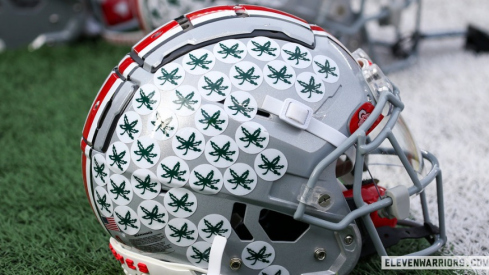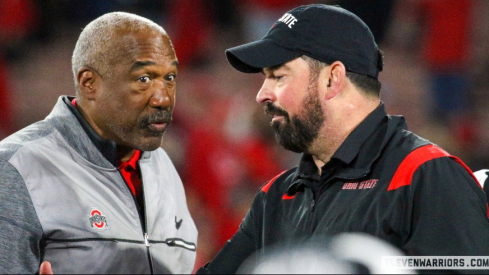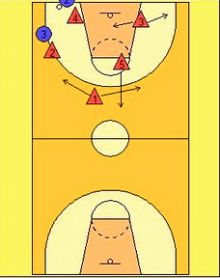 And just like that, you're trapped...
And just like that, you're trapped...While we'll take an inside look at Tennessee at it's entirety before the game tomorrow, there is an element of the Volunteers' game that warrants a little more caution in preparation for the Sweet 16 match-up.
No, we're not talking about coach Bruce Pearl's sweat, rather we are talking about the press his team installs on a regular basis. "The Pearl Press" has a reputation for putting opponents in a frenzy and creating points for the players in the orange jerseys off of the turnovers their defensive tactic creates. While the logistics of the press are fairly basic, actually breaking it in a live game can be quite a challenge.
The formation of the Pearl Press is a 1-2-1-1 and stretches the full length of the court. The purpose of this set up is to create a great amount of pressure on the inbounds pass, leaving teams scrambling to not only get the ball in, but to get the receiver in a position to be able to dribble across the half court line before committing a 10-second violation. If you're lucky enough to get the ball inbounded, Pearl's defense will then swarm that first pass, making it difficult to dribble out of the corner or sideline the handler is forced to or to pass it to a teammate.
Talking personnel, the man guarding the inbounds pass (5) is ideally a tall forward with long arms. The two players in the next level swarming the first pass should be the best on-ball defender (2) and a great anticipation player (3). The next level player should be a very good fast break defender (5), and the final player (1) should be a very fast defender, who can guard sideline to sideline. When set-up, the picture featured with this article is how the defense will look.
Looking at the execution, the inbounds defender stays on his feet, following the ball, and does not jump. Even more interestingly, Bruce Pearl has him counting to five seconds out loud not only to pressure the inbounder, but to let the referee know what the count is for a violation. This tactic makes the passer even more nervous then he already would be with the press or a tight game situation.
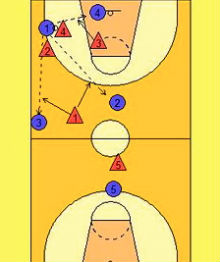 You're not safe just because the pass is in
You're not safe just because the pass is inWhile the pass is being guarded, the other players are basically playing man to man defense until the ball is thrown in. The player represented by "2" in the diagram shadows the near court player, making sure he can't receive the pass. The player represented by "3" in the diagram guards the far side player, using the backboard to his advantage and denying an outlet across the other side of the court. The player designated "1" must cover the court sideline to sideline in order to intercept a pass that may be thrown past the first level. Finally the player designated "5" plays man to man in the next level and shadows a deep receiver if the inbounding team chooses to send someone down court.
If the ball is successfully thrown inbounds, the pressure really heats up, as, upon the pass, defenders "2" and "4" go to the ball and will close in to trap the inbounds recipient. One of the keys to beating the press is getting the ball on the floor before the two defenders close in on you. If the receiving player can beat the trap to the dribble, the press is broken. If the defenders get the trap on, it is not easy to break out of as the other players on the court are all guarded man to man, including the inbounder who is picked up by defender "3". You think with a double-team trap there would be one open man, but that is where the speed defender comes in as he guards the two open players sideline to sideline again in order to intercept a potential pass. When the press gets to this point, it is either close to a 10-second violation or a turnover is likely to occur on an attempted pass.
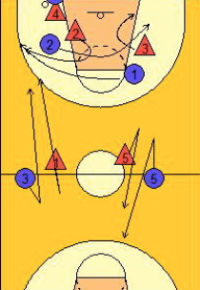 Motion is one way to break the press
Motion is one way to break the pressWhile the trap seems very hard to beat, there are indeed ways Thad Matta can help prepare his team to break it, as, after all, the Bucks have taken care of Tennessee three times in the last few years. The most successful strategy to break the Pearl Press would be using motion to beat the defenders to the ball and create openings to dribble up court and make the game one that uses only the half court. The Vols strength in the press is their speed and recovery time to the ball upon a completed pass, but if the Buckeyes can get their guards in motion and use screens by players not receiving the ball, it may be their best chance to successfully wear down the Volunteer pressure and get fast breaks en route to easy buckets.
Turnovers have been a problem in the tournament thus far, though, especially for The Villian, and that cannot be a recurring issue in this next game. The Pearl Press will exploit any mistakes with regards to handling the basketball and the Buckeyes could be in trouble if they can't protect themselves against it. This defense is very dangerous and a big part of the reason Tennessee has been successful in the post-season during Pearl's time in Knoxville.
The bad news is that Tennessee will be employing their pressure packed defense all game. The good news is the staff has had five days or so to prepare the team for what they will face tomorrow, rather than the one day they would get if this was in the second round of a tournament weekend. Ohio State is the better team for the length of the season, but all that matters is who is better tomorrow at 7:07 PM. If the Buckeyes can break the press regularly and limit turnovers, they will prove to be that better team.
